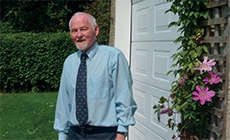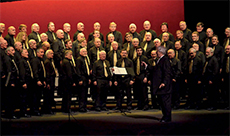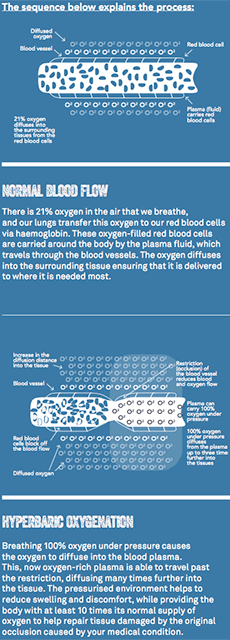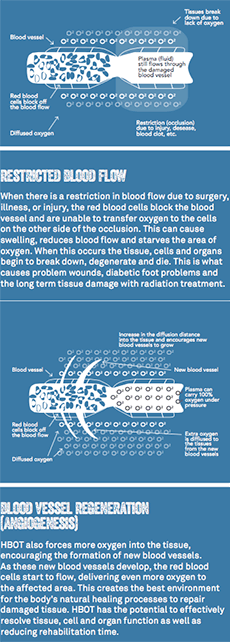




| Home | Features | Club Nights | Underwater Pics | Feedback | Non-Celebrity Diver | Events | 19 April 2024 |
| Blog | Archive | Medical FAQs | Competitions | Travel Offers | The Crew | Contact Us | MDC | LDC |

|

|
 
 |
    ISSUE 20 ARCHIVE - OXYGEN HEALING CASE STUDYStuart GordonMany of you must be wondering what on earth the hulking great tank that is a hyperbaric chamber does all day whilst we're waiting for nitrogen-loaded divers to put in it? Well wonder no longer, as you may or may not be aware at both of our chambers we run daily Hyperbaric Oxygen Therapy (HBOT) treatments for elective therapy patients, meaning non divers.HBOT is widely used in the USA, Australia, Germany and the majority of Europe, however HBOT is little known in the UK, and even less is known of the prolific success that it has in treating conditions such as non-healing wounds, diabetic leg ulcers, radiation proctitis and many many other conditions. How it works:Under normal circumstances, oxygen is transported throughout the body only by red blood cells. With HBOT, oxygen is dissolved into all of the body's fluids, including the blood plasma and lymph. Then it can be carried to areas where circulation is diminished or blocked. The increased concentration means that the gradient for the transport of free oxygen from blood into the tissues is increased at least 10 fold. In this way, extra oxygen can reach damaged tissues and the body can support its own healing process. The increased oxygen also greatly enhances the ability of white blood cells to kill bacteria, reduces swelling and allows new blood vessels to grow more rapidly into the affected areas. It is a simple, non-invasive and painless treatment and patients are required to sit in a hyperbaric chamber for the duration of the session (1hr 45mins), with plenty of room to stretch out, relax and even read, whilst they breathe 100% oxygen at a high pressure. Breathing oxygen at this pressure means that oxygen is dissolved into all of the body's fluids, not just the red blood cells, including blood plasma and lymph, enabling it to reach the damaged tissue. Well we could talk science at you all day but what is really important here is the people that HBOT is able to help, many of whom are even now not aware of it's existence and how it could help them. Therefore we'll let former MDC patient Stuart Gordon take to the floor and explain in his own words exactly how the process helped him: "I have been an insulin dependent (Type1) diabetic since 1963. In early 2011, I developed an ulcer on the left hallux (big toe). I attended the local podiatrist and the diabetic foot clinic at the Royal Hallamshire Hospital in Sheffield for treatment and poor blood circulation to my left foot resulted in the infection being controlled by antibiotics over the next 16 months. In July 2012, the infection began to spread along the hallux and on the advice of my Vascular Consultant, I agreed to have a popliteal to posterior tibial bypass to improve the blood circulation to my left foot. Then by December 2012, I agreed with my Vascular Consultant to have my left hallux amputated because of the pain I was suffering. It was at this point, having read some information about the possible benefits of hyperbaric oxygen (HBO) treatment, that I raised the issue of such treatment with my Vascular Consultant, however he reported that he had no hard research evidence to support this as an effective course of action for my condition. In February 2013, amputation of the left hallux was undertaken. Following the operation, I suffered increasing pain from the open wound and ended up being admitted back into hospital. It transpired that the original bypass had unfortunately occluded and, as a result, the open wound had become necrotic. This lead to a further 5 weeks in hospital and 3 further operations. In late May 2013, I attended a follow-up appointment with the Vascular Consultant. He was concerned at the speed with which healing was taking place and, in particular, how long the angioplasty would continue successfully to aid the healing process. He was unable to offer any specific resolution to the problem other than to continue with a course of antibiotics and ensure effective dressing care. I suggested the use of HBO treatment to expedite the healing process. Although he had no research basis on which to recommend such treatment, he was content for me to pursue this course of action if I so chose. I contacted my local GP to ascertain whether HBO treatment could be funded by the NHS. He expressed the view that any NHS funding was unlikely but was willing to submit an application. He added that a decision on the application was likely to take several weeks. Given that time was of the essence, I chose to self-refer to the Midlands Diving Chamber in Rugby. This meant that I would have to fund the treatment. In June/July 2013, I received forty HBO treatments at the Midlands Diving Chamber over a period of eight weeks. During the HBO treatment, I continued with my course of antibiotics and to have the wound dressed three times a week. I found the environment relaxing and friendly. The facility was well set out, clean, compact and provided good access to meet my needs and the seating was comfortable. Each dive took approximately ninety minutes in the chamber. I had the option to read (the facility has an interesting range of books and magazines), watch DVD's, chat to others or simply relax. On the first two occasions in the chamber, the only minor problem I experienced was having to allow my inner ear to acclimatize to the atmospheric pressure during the dives. Thereafter, I found the eight week process easy to handle and comfortable. Throughout the treatment the staff were friendly, helpful and catered for my specific needs in a thoroughly professional way. During each dive, a member of staff remained in the chamber giving reassurance and advice as and when required. It was also nice that staff offered refreshments on a regular basis. As a Type 1 diabetic, the reason I sought the help of the Midlands Diving Chamber team was the need to facilitate the healing of a foot wound. Without the intervention of the Hyperbaric Oxygen treatment, I firmly believe that the wound would still be causing me problems and may never have healed properly. Following this treatment, I am also grateful for the help given by the specialist vascular nurses in Sheffield and my local nursing services.” — Stuart Gordon (Diabetic foot ulcer treated with HBOT at Midlands Diving Chamber) Stuart's story is just one of many and it is our intention to continue to raise awareness of HBOT in order for more people to be able to benefit from it's results. HBOT can be used to treat conditions such as:
However the major problem that we face in the UK is obtaining adequate funding for patients who desperately require the treatment via the NHS. As Stuart's story highlights, it is extremely difficult for those in need to get funding for treatment and therefore many are either required to fund the treatment themselves or go without. Thankfully London and Midland's Diving Chamber are now BUPA approved, and are 2 of only 3 chambers in the UK who have this status, we also have our own charity: The Diving Chamber Treatment Trust that exists to provide support for particular cases who are unable to receive funding via any other means. For more detailed information on the conditions that HBOT can treat and for evidence and case studies for hyperbaric oxygen therapy, please visit Oxygen Healing or call 020 7806 4021 to speak to a member of the team. |